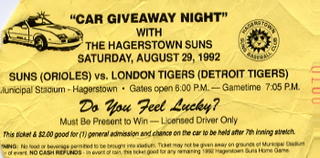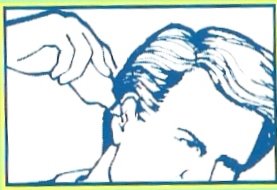On the other hand, it’s the ultimate in accountability. If we’re not doing things right, people won’t contribute. Commercial broadcasters get feedback in the form of people boycotting their advertisers, an indirect pressure at most, since you never know whether consumers would have just stopped buying "Axe Body Spray", anyway. Not that they should have started.
But the public broadcasting paradigm is weird, too, because people not only get high-quality radio in return for their investment, they also get… stuff. Coffee mugs. T-shirts. DVDs. And yeah, tote bags. If you think about it, it’s like the Crest people saying if you buy our toothpaste, not only do you get an effective dentifrice, but we’ll throw in a mitre box. Or if you buy two tubes of toothpaste, you’ll also get a bikini. (A pretty good deal, and an big opening for floss jokes.)
You do have to wonder what happened in the development of public broadcasting in the United States that led someone to hit on the idea of offering tote bags as an incentive for people to contribute to their local TV or radio station. As a news director, I’ve been privy to plenty of audience research data, but strangely, none of it indicates whether public radio listeners, as a group, have more stuff to tote around than the rest of the public at large.
At 19 Minutes World Media Headquarters, one of the most popular thank you gifts in our recent pledge drives has been a crank-powered AM/FM/short wave radio. This may be because it’s a pretty cool device, but it may also be because as a demographic group, northern Arizonans have a staggering number of backpacks per capita, and therefore require few tote bags. (In northern Arizona, babies simply aren’t cool unless they sleep in a Gore-Tex bassinet.)
Still, whether we’re talking tote bags, or crank radios, or Nalgene bottles, the goal is never to obscure the central message of a pledge drive – namely, that the public is the key factor in keeping public radio strong.
It’s a lesson other sectors could stand to learn. Real estate agents tout the re-sellability of houses, rather than whether the house is someplace you’d want to live. People choose a dentist based on whether he or she offers DVD movies as a distraction while a tooth is being filled (whatever happened to music by the 101 Strings?).
Baseball stadiums are increasingly judged on the strength of their non-baseball amenities: Is there a play area for the kids? Can you buy sushi? Does it have a swimming pool? (Then it'd be a good place to wear that bikini you got from Crest.)
Still, I’d have to concede that going to a baseball stadium in 2005 is often a more entertaining (if not necessarily cheaper) experience than it was in years. This observation came to mind after I discovered a ticket stub from a 1992 minor league game in a windbreaker I was wearing the other day. And it was a more remarkable observation than the fact that I was wearing a 13-year old windbreaker.
The ticket stub was from a Hagerstown Suns (who were then a AA-level team) game hyped for the fact they were giving away a car.
 It wasn’t a skill contest and we didn't have to buy a raffle ticket – they were simply going to draw the name of a fan in attendance and give that person a car. The ticket featured a drawing of a shiny sports car. The innings went by until it was time for the drawing – at which point it was revealed that the night’s grand prize was, in fact, a 1984 Plymouth Reliant K. Yes, a K-car! I was at the game with a friend, and we agreed that if either of us won the car, we’d draw straws and the loser would have to drive it home.
It wasn’t a skill contest and we didn't have to buy a raffle ticket – they were simply going to draw the name of a fan in attendance and give that person a car. The ticket featured a drawing of a shiny sports car. The innings went by until it was time for the drawing – at which point it was revealed that the night’s grand prize was, in fact, a 1984 Plymouth Reliant K. Yes, a K-car! I was at the game with a friend, and we agreed that if either of us won the car, we’d draw straws and the loser would have to drive it home.The point here is, the Hagerstown Suns obscured the central point of a night at the ballpark – the baseball game itself. Thirteen years later, I can still remember the stupid K-car giveaway, but I can’t remember which players were using steroids.




No comments:
Post a Comment